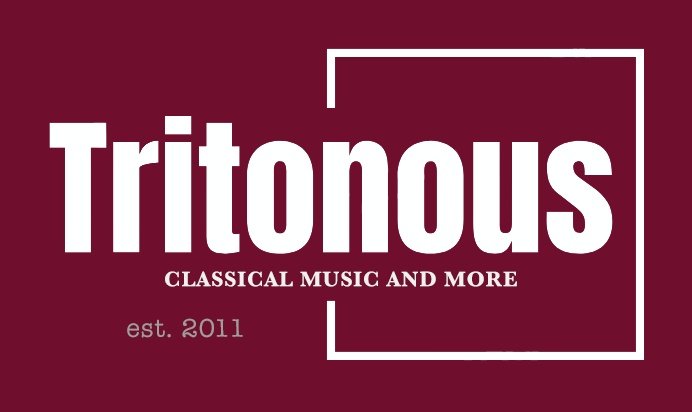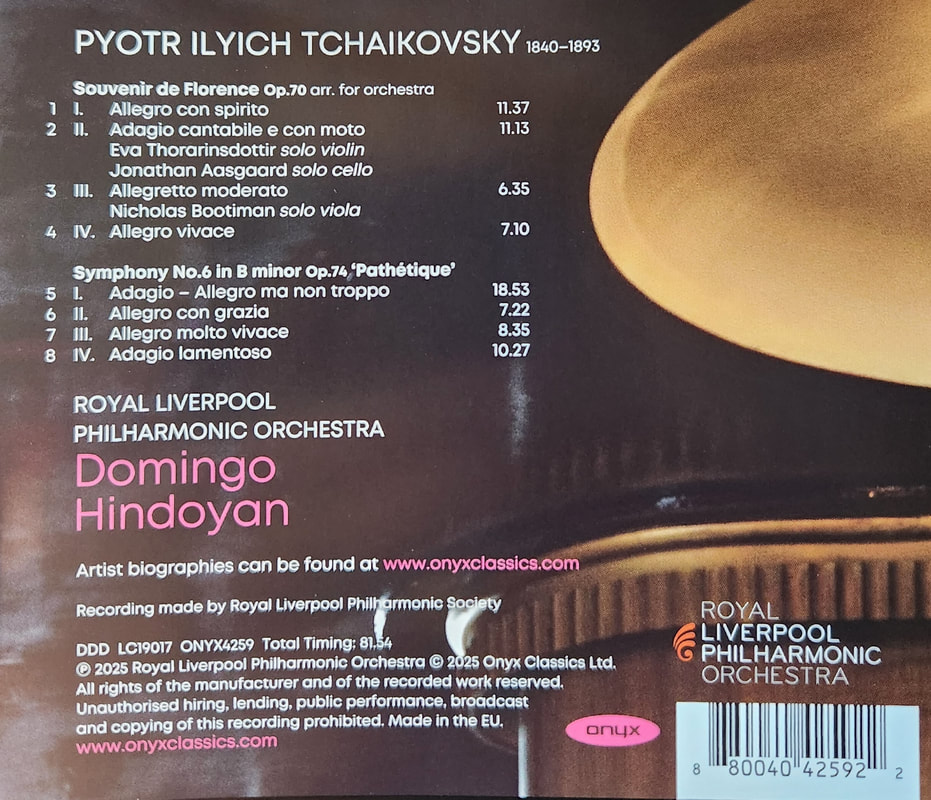So let’s start with what IS special – the coupled Souvenir de Florence, which comes first on the CD. This, of course, is the transcription for string orchestra of the original string sextet. And what better way to show off Hindoyan’s magnificent string section! And in many ways, I think it works better than the original, and I actually like it better. And it’s for a simple reason, really. A full section of strings doesn’t have to work as hard as a string sextet does to produce the full-bodied sound required to do full justice to Tchaikovsky’s many ff markings, where the music simply demands a full orchestral sound. A sextet tends to saw away at it trying to sound larger than they are. And too often it can sound forced, aggressive, or unmusical – or even worse, a combination of all three. That certainly never happens here in Hindoyan’s competent hands. His strings are absolutely, positively glorious.
Not only does he inspire them to play their hearts out, he himself sounds thoroughly inspired by the very essence of the music itself. The first movement, Allegro con spirito is spirited indeed – lilting most delightfully (practically dancing!) – lifted aloft with a joyously impassioned, yet effortless, expressiveness. This opening can sometimes sound terribly heavy when played by a sextet, with an unsuitable intensity which becomes too assertive, starting off with those rolled quadruple-stops. But not here. It’s a vibrant, rich, effortlessly full-bodied sound, with a delectable, airy transparency to the textures. And there’s a silkiness too (especially in the violins) that only massed strings can produce. It’s the complete opposite of what we often hear from a sextet when they’re working too hard at it.
Even in the Adagio, there is a sweet, airy silkiness to the violin lines over delicate pizzicato 2nds and violas beneath them. Not weighed down with too much passion, even at its most impassioned moments, there is a simple, singing expressiveness which is enchanting. The Allegretto (with a gorgeous viola solo by the way), is again airy and transparent, pensive yet lifted aloft without heaviness.
The finale isn’t quite as vivace as I was expecting, but dynamics are expertly contrasted (which isn’t always possible at breakneck speed). And Hindoyan manages to find, and highlight, some wonderful duet passages – with separated violins in harmony, together and sometimes with violas or cellos an octave below. It’s lyrical and charming in a way not easy to describe. It sounds like chamber music. That’s precisely it – chamber music – just as originally conceived. Every minute variation of dynamics, tonal colors, and speed and intensity of vibrato is instantaneously produced in response to direction from the podium – played as one, with complete unanimity from the entire ensemble.
Hindoyan even finds a bit of gravitas there in the more passionate central section, exploiting the richness and body of tone that only a full string section can produce. And as the momentum and bustling athleticism increase, the music never turns helter-skelter (as can so often happen); Hindoyan keeps firm control over his players, not allowing them to rush it. But there’s certainly no lack of excitement – the ending is as thrilling as you’ll ever want to hear it.
I have never been so moved or captivated by this piece before. Hindoyan reveals it to be one of Tchaikovsky’s true masterpieces – perhaps even more so than his more famous Serenade for Strings.
After this, I was reluctant to move on to the 6th Symphony which follows immediately on the next track. It just felt strange – that pianissimo, sorrowful bassoon coming right after the exhilarating finale of Souvenir. But that’s the way they programmed it. (And it wouldn’t have been any better the other way around. So maybe – just a thought here – maybe these weren’t the most logical or ideal disc mates. For more reasons than one.) So grudgingly onward I went. And sadly, it can’t begin to measure up.
After a nicely flowing introductory Adagio, I soon began to notice the recorded sound is a bit gray and lackluster compared to Souvenir. And as the music (and volume level) heats up, I hear the acoustic is a bit stuffy, and the dynamics a bit compressed. And curiously, it’s a string-forward sound which persists as it goes (and becomes even more apparent in the final two movements).
Aside from that, right from the first Allegro, it’s clear this is going to be a rather lightweight reading. And that impression continues in the statement of the main Andante theme, which is simple and flowing, rather than pensive or enriched with a touch of fervor. Then the major climactic section which follows is devoid of histrionics, lacking even some essential melodrama. We hear a thick, string-forward sound, constrained somewhat by a cramped acoustic and compressed dynamics. And the brass, at their first entrance, already sound like they’re tired – or perhaps intimidated, after years of Petrenko’s propensity for buttoned-down, well-mannered refinement. And the recorded balance doesn’t help, which recesses them way back behind the strings.
The Allegro con grazia is unremarkable – gracious and elegant, at a nicely flowing tempo. And unfortunately, the molto vivace is equally unremarkable. It’s well played, but not nearly as exciting as I was hoping from this energizing conductor. He generates some joyousness in the second half’s ff march sections, but it’s nowhere close to exhilarating. And again I’m bothered by the unnatural, string-heavy balance. While it’s interesting to hear them scurrying around with such clarity and focus, how I wish the brass would open up with some real power! And again, the engineer is largely to blame in favoring the strings so prominently with the microphones, which all but precludes the brass from making an impact no matter how loud they play. (Same with the bass drum.) Moreover, as Hindoyan encourages the orchestra to give him more and more, the recording just seems to restrict them more and more – making me wonder if this was originally recorded for a radio broadcast.
The finale is somewhat better. The strings at last give us some passion, while Hindoyan keeps things simple and moving forward without weighing it down too much. But just as things are getting good, the first big climax arrives only to find the brass MIA. Again. It’s as if they’re confined in an entirely different room in the back. And the strings seem to have moved even closer, creating a thick, rough-hewn wall of coarse-textured sound which is borderline unpleasant.
Perplexed by the pronounced disparity in musical involvement and (especially) recorded sound between the two recordings on this CD, I turn to the booklet and immediately find an explanation. The Symphony was recorded “live” back in 2021, just after Hindoyan became the RLPO’s chief conductor. (This may actually have been the first concert of their inaugural season.) And the performance sounds like the orchestra and conductor are still getting acquainted and not entirely comfortable together yet. And one wonders why this overplayed, overfamiliar Tchaikovsky warhorse was chosen for this concert. I suppose it drew in a big crowd to welcome their new conductor. So I get that. But, given the mediocre recorded sound, why did Onyx then resurrect it 4 years later as coupling for a glorious new recording of Souvenir de Florence? (One wonders what else was on that 2024 program along with Souvenir, and why Onyx didn’t give us that instead?) I also noted that Souvenir was recorded in a different venue than their usual Liverpool Philharmonic Hall (where the symphony was played). For unknown reasons, it was recorded at the Tung Auditorium, Yoko Ono Lennon Center. How odd. But the acoustic there is marvelous, allowing Onyx to produce one of the best-sounding recordings I’ve ever heard from the label. Maybe they’ll record them there more often.
In the end, the recorded sound is a major contributing factor in the overall satisfaction and disappointment of this release. Maybe the audience who attended that 2021 concert of the 6th Symphony will be happy to have it memorialized on CD, but for the rest of us, it’s irritating that Onyx has underhandedly stuck it in there alongside a wonderful new recording. This CD plays for an astonishing 82 minutes, which is impressive, so it’s up to each of us to decide whether just 38 minutes of it is good enough to justify the cost of this disc. As I have found myself humming all those glorious tunes in Souvenir literally for days afterwards, I suppose for me it is. And I suppose it’s also interesting to hear what Hindoyan has accomplished with this orchestra in just 3 years (a “before” and “after” example, if you will). He has matured as a conductor and built this orchestra into one of real stature. And subsequent recordings demonstrate how much the Onyx engineers have improved at recording them in their own hall since that 2021 concert. So there’s that.









